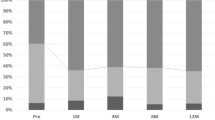Abstract
The primary treatment for obstetric sphincter injury is overlapping sphincteroplasty. However, despite restoration of the anatomy, only 65 percent of patients are fully continent. PURPOSE: This study was undertaken to determine if postoperative biofeedback improved continence in patients with poor functional outcomes after sphincteroplasty. METHOD: Outcomes of 28 patients who underwent electromyographic biofeedback training after sphincteroplasty for obstetric sphincter injury were reviewed. Nine patients had an accompanying levatorplasty. Average age was 34 (range, 23–57) years. Patients began biofeedback a mean of 32 (range, 2–192) months postoperatively. Before beginning biofeedback, patients completed an incontinence questionnaire, bowel diary, and scored their incontinence. At the end of treatment, they were again asked to score their incontinence and rate their improvement. Using an incontinence scale with a maximum score of 30, the average incontinence score before biofeedback was 20 (range, 13–30). Incontinent episodes per week ranged from one to nine. Sixteen patients were incontinent to solid stool. RESULTS: Overall, the average posttreatment incontinence score decreased from 20 to 3 (P < 0.0001). Average number of incontinent episodes per week decreased from 5.4 to 1.4 (P < 0.0001) Twenty-five patients (89 percent) reported improvement in their continence. All had a posttreatment incontinent score of less than three. Three patients noted no improvement. Of those, one subsequently had a colostomy, one is waiting the implant of an artificial anal sphincter, and one has sought no further treatment. There were no complications reported. CONCLUSION: Biofeedback improves functional outcome after sphincteroplasty and is a reasonable option for patients with less than optimum outcome after sphincteroplasty.
Similar content being viewed by others
References
Yoshioka K, Keighley MR. Sphincter repair for fecal incontinence. Dis Colon Rectum 1989;32:39–42.
Hawley PR. Anal sphincter reconstruction. Langenbecks Arch Chir 1985;366:269–72.
Ctercteko GC, Fazio VW, Jagelman DG, Lavery IC, Weakley FL, Melia M. Anal sphincter repair: a report of 60 cases and a review of the literature. Aust N Z J Surg 1988;58:703–10.
Fang DT, Nivatvongs S, Vermeulen FD, Herman FN, Goldberg SM, Rothenberger DA. Overlapping sphincteroplasty for acquired anal incontinence. Dis Colon Rectum 1984;27:720–2.
Fleshman JW, Dreznick Z, Fry RD, Kodner IJ. Anal sphincter repair for obstetric injury: manometric evaluation of functional results. Dis Colon Rectum 1991;34:1061–7.
Gibbs DH, Hooks VH. Overlapping sphincteroplasty for acquired anal incontinence. South Med J 1993;86:1376–80.
Wexner SD, Marchetti F, Jagelman DG. The role of sphincteroplasty for fecal incontinence reevaluated: a prospective physiologic and functional review. Dis Colon Rectum 1991;34:22–30.
Morgan S, Bernard D, Tasse D, Wassef R. Results of Parks' sphincteroplasty for post traumatic anal incontinence [meeting abstract]. Can J Surg 1987;30:299.
Jacobs PP, Scheuer M, Kuipers JH, Vingerhoets MH. Obstetric fecal incontinence: role of pelvic floor denervation and results of delayed sphincter repair. Dis Colon Rectum 1990;33:494–7.
Cerulli MA, Nikoomanesh P, Schuster MM. Progress in biofeedback conditioning for fecal incontinence. Gastroenterology 1979;76:742–6.
Engel BT, Nikoomanesh P, Schuster MM. Operant conditioning of rectosphincteric responses in the treatment of fecal incontinence. N Engl J Med 1944;290:646–9.
Wald A. Biofeedback therapy for fecal incontinence. Ann Intern Med 1981;95:146–9.
Whitehead WE, Burgio KL, Engel BT. Biofeedback treatment for fecal incontinence in geriatric patients. J Am Geriatr Soc 1985;33:320–4.
Rothenberger DA. Anal incontinence. In: Cameron JL, ed. Current surgical therapy. 3rd ed. Philadelphia: BC Decker, 1989:186–94.
Monthly vital statistics report, U.S. Hyattsville: Bureau of Vital Statistics, 1993.
Sultan AH, Kamm MA, Hudson CN,et al. Anal sphincter disruption during vaginal delivery. N Engl J Med 1993;329:1905–11.
Nielsen MB, Dammegaard L, Pedersen JF. Endosonographic assessment of the anal sphincter after surgical reconstruction. Dis Colon Rectum 1994;37:434–8.
Jensen LL, Lowry AC. Biofeedback for anal incontinence: what is the mechanism of success? [meeting abstract]. Dis Colon Rectum 1992;35:11.
Loening-Baucke V. Efficacy of biofeedback training in improving fecal incontinence and anorectal physiologic function. Gut 1990;31:1395–402.
McHugh S, Kersey K, Diamant NE. Biofeedback training for fecal incontinence: outcome according to physiological parameters. Gastroenterolgy 1988;94:A295.
Miner PB, Donnelly TC, Read NW. Investigation of mode of action of biofeedback in treatment of fecal incontinence. Dig Dis Sci 1990;35:1291–8.
Author information
Authors and Affiliations
Additional information
Read at the meeting of The American Society of Colon and Rectal Surgeons, Seattle, Washington, June 9 to 14, 1996.
About this article
Cite this article
Jensen, L.L., Lowry, A.C. Biofeedback improves functional outcome after sphincteroplasty. Dis Colon Rectum 40, 197–200 (1997). https://doi.org/10.1007/BF02054988
Issue Date:
DOI: https://doi.org/10.1007/BF02054988




